|
|
Post by buckmana on Jan 8, 2010 20:07:05 GMT -5
I went to see Princess and the Frog a couple of days ago.
And from time to time, I noticed a few references to a Little Mermaid.
The first is at the costume party, there's a woman in a mermaid costume that echoes Ariel and someone wandering around in an octopus costume.
The next references are in the parade sequence.
King Triton, you can't miss him!
A mermaid that looks a lot like Alana appears in the upper corner shortly after this.
|
|
|
|
Post by buckmana on Feb 25, 2011 8:08:31 GMT -5
Some context before you get to the hyperlink for the image. Fathom is a comic about a water powered superheroine. Aspen (the lead character) can breathe/swim underwater and has many powers relating to water and possibly some relating to weather control. Every so often, the company that produces the Fathom comic makes a poster book showcasing their lead characters. When I got to this page, I had to laugh out loud: imgur.com/st0aRZALet's play Spot the Little Mermaid references!  Aspen is the woman on the aft seat of the boat. |
|
|
|
Post by buckmana on Mar 15, 2013 23:23:36 GMT -5
The W.I.T.C.H. comic artists seem to play a game called "how many Disney references can we sneak in?" I've seen a few TLM references and have compiled them for you: Issue 10, page 29  That ornament on the side of Leafy's tank reminds me of a certain redheaded mermaid.  Captain Obvious (issue 51, page 4 & issue 55, page 62)  Irma is the Water Guardian, so they can't resist being as obvious with the reference as is possible! Issue 101, page 14  This fish has a similar look to Flounder and the exact same colors. Original scans sourced from Mooncloud's witchoholics site. |
|
|
|
Post by buckmana on Mar 8, 2014 6:34:30 GMT -5
Found another TLM reference in Fathom. In the movie, Ariel is actually facing the other way, but I turned her to face the same direction so you can compare the poses:  This is during the end of the first story arc, where Aspen has just saved the world, has been presumed dead and has just surfaced to show she actually lived. She's the figure who is in silhouette because the sun is behind her. It also looks like both pictures are at sunrise (or sunset), because the light is the same. There is one more similarity which (in both Fathom and TLM) you only see after the heroine has surfaced. Killian, the major villian for most of the series, has white hair, just like Ursula. He has a happier fate then her though, as he eventually stops being evil and starts working for his former enemies as leader of their army. I wonder if there are any more TLM references I have missed? Now that I know the publishers are slipping them in, I'll make sure to look at the comics very carefully the next time I read them and see if I can find some more. There is a spinoff character in Fathom called Kiani. Her next comic issue features a series of movie posters redesigned with a chibi Kiani. This one was very familiar:  And just for an extra level of reference, Kiani is partially a redhead, her hair is red and blonde stripes. They've never explained that, but my theory is her unusual coloration (purple eyes, red/blonde hair, minor albinoism) gave her some unusual genetic characteristics. It's definitely not dyed, since they've shown her at various ages and it's always been the same. |
|
|
|
Post by buckmana on Mar 11, 2018 10:21:02 GMT -5
A verbal reference in the Doc McStuffins episode Smitten with a Kitten, Chilly wonders if the reason the kitten cannot talk is "because a wicked sea witch stole her voice". No, this was not the cause, apparently the kitten was technically a real animal, not a talking toy and therefore, never had a voice, only cat noises. |
|
|
|
Post by veu on Mar 24, 2018 6:12:06 GMT -5
Wonder Woman and The Little Mermaid:  Here an article from Fairytalefanboy.blogspot: Wonder Woman Vs. The Little Mermaid
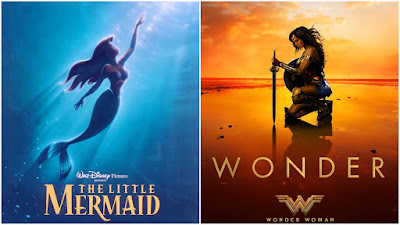
At the moment, the most significant movie in cinemas is Wonder Woman, the first live-action movie to centre on the iconic DC Comics heroine (An animated movie was released direct-to-DVD in 2009) and the latest instalment in the DC Extended Universe, which has also included Man of Steel and Suicide Squad. The Wonder Woman comics always been heavily inspired by Greek mythology, as the eponymous heroine (real name Diana), the Princess of the Amazon island of Themyscira, is the daughter of Zeus, with her superpowers given to her by the Greek gods. However, the new Wonder Woman movie takes a lot of inspiration from a variety of more modern sources, with one film in particular providing a significant and unlikely influence. Allan Heinberg, who wrote the script for Wonder Woman, has admitted that it was heavily inspired by the Disney classic The Little Mermaid. Given the darker and edgier tone of the DCEU, it may seem odd to use this family-friendly film (which turned a tragic Hans Christian Andersen story into an upbeat musical) as inspiration. However, the risk has definitely paid off. Wonder Woman has become the first DCEU movie to gain critical acclaim (It currently has 93% Fresh score on Rotten Tomatoes, with over 285 reviews), and the first movie directed by a woman to earn over $100 million in America in its opening weekend.
The clearest link between Wonder Woman and The Little Mermaid is the similarity between their basic plots. Both centre on a strong and inquisitive female protagonist who saves a handsome male from drowning, and leaves her idyllic home to follow him to the human world. However, the similarities go much further than this, with both movies also featuring handsome and adventurous male leads, nasty female villains who specialise in creating deadly potions, and a big, spectacular climax. There are also several differences between the two movies. Wonder Woman places much more emphasis on the dark side of the human world, and is set during 1918, at the climax of World War One, whilst The Little Mermaid is set in an unspecified period in the past (presumably during the mid-19th century). This post will compare the two movies in greater detail, examining the parallels between them and the ways in which they utilise familiar tropes in order to create something unique and memorable.
The Heroine
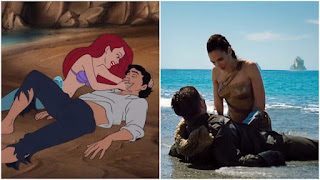
Both films feature protagonists defined their willingness to learn and discover more about the world. Wonder Woman’s inquisitive nature is established very early on in her film. We see her as a child, asking her mother, Queen Hippolyta, about the history of the Greek gods, and seeking information about the weaponry which her fellow Amazonians use. Wonder Woman wants to be a warrior, but recognises that in order to fulfil this destiny, she has to learn more about the worlds which she is going to fight for. Meanwhile, in The Little Mermaid, the curiously of the titular mermaid, Ariel, is made clear in her “I Want” song, “Part of that World”, as she sings about wanting to experience life in the human world and expresses her desire to “know what the people know”. In spite of this enthusiasm for learning, both characters are fish out of water in the human world, making them unfamiliar with various human items and customs. Whilst in Prince Eric’s palace, Ariel combs her hair with a fork and mistakes a pipe for a musical instrument. Even though Wonder Woman is a much more serious movie, the titular heroine’s discoveries about the human world are often played for comedy, as she learns about marriage, struggles with a revolving door, and even finds time to eat an ice cream on the way to the Western front. In both cases, the way in which our protagonists react to even the most mundane aspects of the human world highlights their innocence and likeability, making it easier to root for them.
However, both Wonder Woman and Ariel both have the same major flaw – naivety. When Ursula gives her a contract to make her human for three days in exchange for her voice, Ariel impulsively accepts, not aware that her inability to speak is going to make it much harder to gain Eric’s love within the time limit. Meanwhile, Wonder Woman literally believes that she can end “the war to end all wars “merely by vanquishing Ares. One major advantage of setting Wonder Woman in World War One is the fact that it places the idealistic heroine in a conflict primarily remembered for being “futile”. The First World War was the result of a complex series of diplomatic disputes, and this reality directly challenges Wonder Woman’s perception that a problem like war has a simple cause and a simple solution. The coming-of-age narrative in both movies ties in with a loss of innocence, but this is especially apparent in Wonder Woman, and the contrast between her beliefs and the reality of the conflict adds to the drama.
Atlantica vs. Themyscira
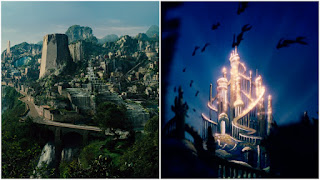
Both Wonder Woman and Ariel come from a paradise which is deliberately cut off from the human world. Ariel’s homeland, Atlantica, is populated by mermaids and a wide array of sea creatures. Themyscira is depicted with green grass and blue skies, with the bright colours contrasting with the grey and chaotic human world. As beautiful as Atlantica is, it doesn’t really get explored in much detail in The Little Mermaid, as it plays no part in the story and relationships involved – focusing too much on depicting life underwater would take attention away from Ariel and her dream of exploring the human world which fascinates her so much. However, in Wonder Woman, we see more of Themyscira, as we learn how Wonder Woman and her fellow Amazons train to be warriors. Their mythology is explained in detail, introducing viewers to the origins of the Amazon race and their conflict with Ares, the fearsome god of war. As most viewers of Wonder Woman are not familiar with the comics, the film has to make an extra effort in order to gain their attention and make Wonder Woman and her world as appealing as possible. Spending more time exploring Themyscira at the start of the movie makes this much easier to do.
The Love Interest
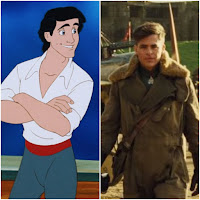
The Little Mermaid is a romance first and foremost, meaning that Ariel’s relationship with Prince Eric is the most important aspect of the film. It is also one of the most problematic, as Ariel and Eric have not properly interacted with each other before Ariel decides to risk everything in order to gain true love’s kiss from him. That said, Ariel spends enough time spying on Eric before the storm starts to learn that he’s kind, modest, and adventurous and looking for the perfect wife. In short, it’s obvious that he’s not the barbarian which her father, King Triton, accuses all humans of being. Compared to the princes from earlier Disney films such as Cinderella and Sleeping Beauty (who were mere plot devices), Eric has a bit more depth, as he finds himself torn between the “dream girl” with the beautiful singing voice who saved his life and the lively mute staying in his castle, not knowing that they are actually one and the same. However, this dilemma is relatively underdeveloped, ensuring that Prince Eric still seems too perfect, leading to the common complaint that he’s a bland love interest.
Whilst Ariel is often accused of becoming human just to win the heart of a guy, Wonder Woman’s reasons for seeking out the human world are not related to romance. However, her relationship with Steve Trevor provides Wonder Woman with a lot of its heart. He specialises in working as a spy, going undercover in German territory, and has a good reason to describe himself as an “above average” male. Although his experiences have made him all too aware that humans are capable of great evil, he is still committed to protecting as many people as possible, claiming that “my father once told me that when you see something wrong happening in the world, you can either do something or do nothing, and I’ve already tried nothing.” Steve’s willingness to fight for peace in spite of his understanding of how violent and cruel humanity can be, proves to be a major inspiration for Wonder Woman, and ensures that he’s just as compelling a character as she is.
View on Humanity
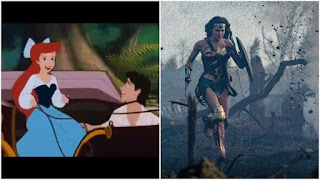
Aside from the characters and storyline, a key aspect of both movies is their depiction of the human world which both Wonder Woman and Ariel find themselves exploring. The Little Mermaid portrays the human world in an extremely positive fashion. Although Sebastian the crab has a run-in with a deranged French chef (played entirely for cartoonish comedy), Ariel generally sees the best side of humanity during her three days on land. Eric and his staff treat her very well, and she gets to spend time in a luxurious castle and a bright sunny town, seeing puppet shows and experiencing carriage rides. The film is primarily focused on validating Ariel’s belief that the human world is not as bad as King Triton fears, reinforcing the message that it’s worth taking risks and challenging prejudices. This means that the problems with the human world are heavily downplayed. In contrast, Wonder Woman learns far more about the negative aspects of the human world. Heading to fight, she sees numerous crippled soldiers, and is disgusted by the conduct of the British government, which is willing to let countless men die on the battlefields. However, in spite of all the death and destruction she sees during her time in the human world, Wonder Woman eventually realises that “only love will truly save the world” as there will always be people like Steve Trevor willing to do heroic deeds in the name of securing peace. Both movies ultimately believe that the human race is worth fighting for, but Wonder Woman highlights the brutality and complexity of our world, making it much more balanced than the overly idealised portrayal of humanity in The Little Mermaid.
Side Characters
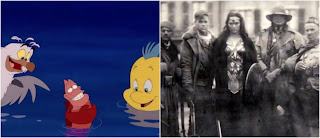
Wonder Woman and Ariel are aided in their missions by a small band of memorable sidekicks. In order to gain True Love’s Kiss from Eric, Ariel relies on the support of her friends Sebastian the crab, Flounder the fish and Scuttle the seagull. Flounder is a cute and expressive sidekick, whilst the feather-brained Scuttle provides Ariel with some wonderfully inaccurate information about the human world. However, Sebastian is easily the best of the comic relief sidekicks. His anxious, panicky personality generates a lot of humour, but when he starts singing songs like “Under the Sea” and “Kiss the Girl”, he changes into a confident, smooth and energetic showman. In addition, Sebastian’s willingness to aid Ariel in spite of his opposition to her rebellious ways gives him a greater level of depth. Sebastian is one of the most developed characters in The Little Mermaid, and children and adults love him as much as (if not more than) Ariel and Eric.
In contrast, the side characters in Wonder Woman are much less important. Steve’s secretary, Etta Candy is a lively and likeable individual, but she only really appears in the relatively short sequence set in London. Whist fighting in France, Wonder Woman and Steve are assisted by three soldiers: Sameer, a master of disguise from Africa, Charlie, a Scottish marksman and Chief, a Native American mercenary. These characters have some amusing quirks which allow them to stand out, and the brief mentions of their backstories (Charlie has nightmares about his experiences in combat, Sameer became a soldier after being rejected as an actor due to his race) subtly highlight the unpleasant aspects of the human world. They provide Wonder Woman with invaluable help in her mission, but they primarily function as part of the scenery without trying to steal the show.
Villains
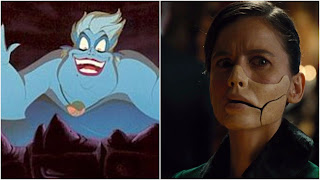
In order to make life even harder for them, an innocent in an unfamiliar world needs to come up against an extremely dangerous villain. In its conniving baddie Ursula, The Little Mermaid features one of the greatest ever Disney villains. A tentacled troublemaker plotting to take over Atlantica, Ursula revels in her grotesque nature, eating live shrimp and turning merfolk into wretched worm-like creatures for her own amusement. She is skilled at exploiting Ariel’s vulnerability, claiming that her spells can solve the mermaid’s problems and allow her to pursue her dreams. However, Ursula will do anything to ensure that she can usurp King Triton’s throne, so she has no intention of allowing Ariel to gain her happily ever after. Wonder Woman also features a wicked witch of its own in Doctor Maru, nicknamed Doctor Poison by Steve. Doctor Maru is a chemist working for General Ludendorff, the head of the German army. She creates a number of deadly weapons, including pellets which can increase Ludendorff’s strength, and a type of poison gas which can be used to wipe out entire villages. With her deformed face (she has several facial disfigurements hidden by a porcelain mask), sinister eyes which highlight her sadistic nature, and her willingness to test her bioweapons on various unlucky people, Doctor Maru is a memorably nasty character. Although she’s relatively underused and pretty flat, Doctor Maru is a prominent example of the archetypal “baroness” (Wonder Woman’s first archenemy in the comics, Baroness Von Gunther, also epitomises this character type). Sadistic, powerful and lacking inhibition, Doctor Maru essentially represents a 20th century version of the wicked witch, creating chaos and devastation using science and technology instead of the magical spells and potions which Ursula specialises in.
For all the devastation which Doctor Poison is planning to unleash, there are even greater threats. Wonder Woman is the latest in a long line of recent blockbusters to feature a “Surprise Villain”. Sir Patrick Morgan, a diplomat who initially seems to be working to end World War One, is eventually revealed to be Ares himself. He has secretly been using his powers to influence belligerents such as Ludendorff and Doctor Poison, and aims to make the war continue until mankind has completely destroyed itself. Although he’s able to teleport from place to place in the blink of an eye, resist Wonder Woman’s special weapons and send trees flying through the air with a flick of his wrist, Ares prefers to work in the shadows, manipulating humans into acting on their own selfish and destructive desires. His ability at exploiting the worst traits of mankind contrasts with Wonder Woman’s belief that humans are inherently good. The “Surprise Villain” is rapidly becoming an incredibly annoying trope, but Ares ability at hiding his true nature demonstrates that some of the deadliest villains in the human world are those able to prey on the flaws and prejudices of others.
The Final Battle
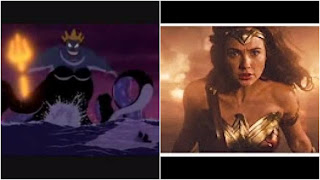
Even avid fans of Disney’s The Little Mermaid will admit that the third act is one of the weakest aspects of the film. Although the final battle, in which Ursula essentially turns into Cthulhu and tries to finish off Ariel and Eric, is wonderfully spectacular and over-the-top, Ariel is reduced to a damsel-in-distress, doing little to defeat Ursula. As Ariel is the one who caused this situation in the first place, she should be taking charge and defeating Ursula, thus demonstrating how much she’s grown as a character since she initially accepted Ursula’s deal. The climax of Wonder Woman also relies heavily on spectacle, with Wonder Woman facing off against Ares whilst Steve and his friends race to destroy Ludendorff’s poison gas before it can be used in combat. However, unlike the final battle in The Little Mermaid, this conclusion provides a substantial test of Wonder Woman’s character, as the all-powerful Ares tries to convince her to abandon mankind. It’s a little bit disappointing that the men are ultimately the ones who ultimately stop the Germans, but their actions are necessary to convince Wonder Woman that mankind is ultimately worth saving from Ares. In both films, the big heroic gestures are ultimately done by men (Eric saving Ariel and destroying Ursula, Steve sacrificing himself to blow up the last supplies of the bioweapon) but at least the ending of Wonder Woman manages to centre on the decisions of the female lead and complete her character arc in a powerful and satisfying fashion.
Conclusion
Both The Little Mermaid and Wonder Woman are good movies, but they have different strengths and weaknesses. Wonder Woman and Steve Trevor are a more interesting central couple than Ariel and Eric, but the side characters and villains of The Little Mermaid are far superior to the merely functional ones used in Wonder Woman. The Little Mermaid is an optimistic and enjoyable film, but Wonder Woman centres on a more realistic and better-developed world, with more complex and thought-provoking themes and subject matter.
In some respects, it can be reductive to compare the two films when they belong to different genres (Wonder Woman is an action-adventure, The Little Mermaid is a primarily a romantic comedy), with different tones. Wonder Woman probably has greater depth, with WWI setting and its themes about sacrifice and the loss of innocence. It helps that the movie is around 50 minutes longer than The Little Mermaid, and a lot of this extra time is used to explore the complexities of the human world. However, The Little Mermaid is probably better as entertainment, due to its memorable characters, colourful animation and those legendary songs which have made it one of Disney's best-loved musicals. Ultimately, the success of both Wonder Woman and The Little Mermaid highlights the timeless appeal of a coming-of-age tale. Both films turn classic source material into engaging and unique entertainment, with strong and hopeful messages, memorable characters, and most importantly, a simple but compelling storyline which can be engage and inspire viewers of both genders all over the world. |
|
|
|
Post by buckmana on Aug 6, 2020 5:39:15 GMT -5
Found one from the soft reboot of Powerpuff Girls:  Blossom as a mermaid. She even sang a version of Ursula's enchantment song. For context, this scene is a paranoia fuelled nightmare of Princess (the girl in the background), she's imagining Blossom as a siren. |
|
|
|
Post by veu on Aug 6, 2020 7:57:04 GMT -5
There are references of The Little Mermaid in anime Pretty Cure franchise. * In " Yes! Pretty Cure 5 GoGo!" Episode 40 Return Urara's Singing Voice! (うららの歌声を取り戻せ! Urara no Utagoe o Torimodose!?). Synopsis: Urara dedicates herself to land an upcoming role. Using this, Shiribetta forces the Cures into the story of "The Little Mermaid" and steals her voice.
 * In " HUGtto! Pretty Cure", Episode 32: Is This Magic? Homare Is A Mermaid Princess! (これって魔法?ほまれは人魚のプリンセス! Kore tte Mahō? Homare wa Ningyo no Purinsesu!?) Synopsis: As Homare searches for ideas for her ice skating music, she comes upon the story of The Little Mermaid. However, an Oshimaida is requested from Bicine that traps Cure Étoile and Harry in the story of The Little Mermaid. The other Cures desperately try to find a way to help their friends escape from this crazy situation.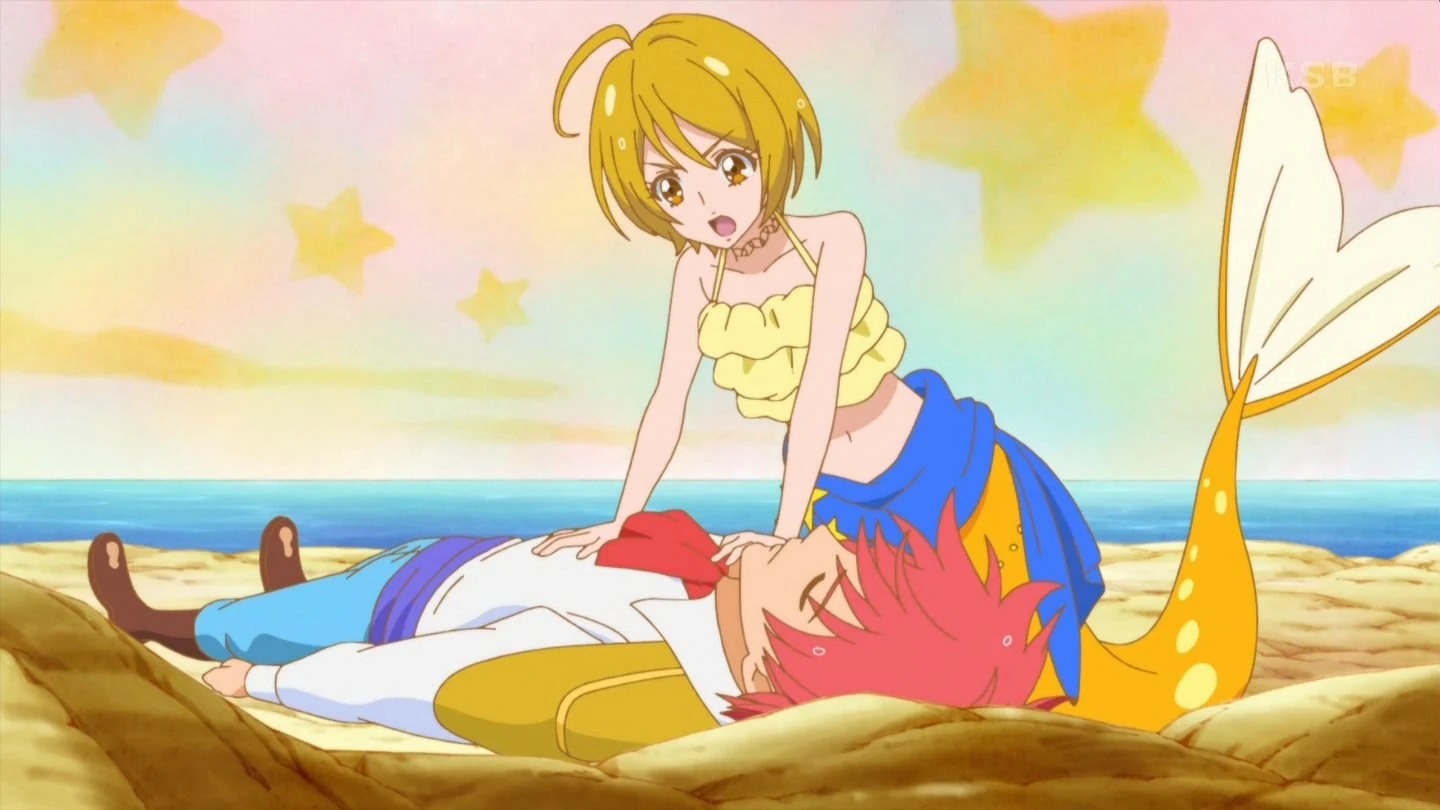 |
|
|
|
Post by veu on Aug 6, 2020 8:15:51 GMT -5
* Hariel is a minor character and a parody of Ariel from The Little Mermaid in the Cartoon Network animated series, The Grim Adventures of Billy and Mandy episode " Hey, Water You Doing?": 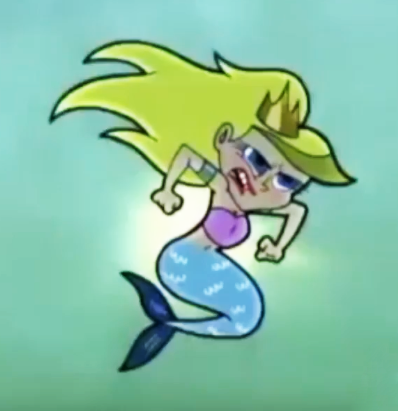 * Aglaope in the animated series Mission Odyssey. She appears in The Song of the Sirens. 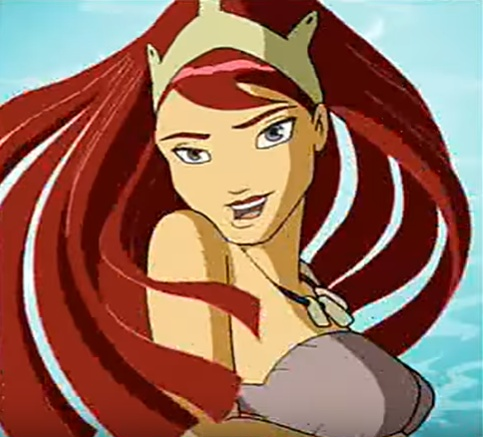 * Lorelei is a character from The Tangerine Bear:  * Marina is the mermaid character in Xilam's animated series Zig & Sharko:  |
|
|
|
Post by yougottaloveariel on Aug 6, 2020 10:23:51 GMT -5
As I type this I use my recently acquired I phone since hurricane has screwed my net service. Half of these I already mentioned. By the way JOdi BEnson was in two eps of Billy and. Mandy. She plays a mother aligator in one and the blue fairy in a Pinocchio parody which parodies SEbastian as a rapper. You forgot Sabans Aqurian from Gummi Bears. And Readers Digest. There are others to list as I hastily type this. Gotta go to cable company to find out WHAT is wrong with my service
|
|
|
|
Post by veu on Aug 7, 2020 14:35:19 GMT -5
From CBR: Constantine Just Turned The Little Mermaid Into a NIGHTMARE
John Constantine's latest case puts a bizarre twist on the classic Disney story that will make you afraid to get back into the water.
BY JACOB NARDONE
7 HOURS AGO
WARNING: The following contains spoilers for John Constantine: Hellblazer #8, by Simon Spurrier, Aaron Campbell, Jordie Bellaire, and Aditya Bidikar, on sale now.
The latest issue of John Constantine: Hellblazer serves as a dark parallel to the beloved Disney story The Little Mermaid where a mermaid falls in love with a human fisherman. Where the Disney movie is a happy coming of age tale, this story arc serves as a dark and terrifying warning about love and ideas.
What starts as a familiar story of a young Mermaid who meets a human man and falls into a love that blinds her leading to her emergence from the sea ends in death and tragedy. The Hellblazer weasels his way into these tragic events to enact the questionable form of magical justice he is well known for.

John Constantine Little Mermaid
Like most Disney films, The Little Mermaid offers a rose-colored view of the world that results in a happy ending for its main characters as Ariel marries Prince Eric and becomes human. Simon Spurrier and Aaron Campbell's John Constantine: Hellblazer #8 reframes the story in a far more macabre context.
In this story, the mermaid falls in love with a British fisherman who is having trouble keeping up with the French to make ends meet. Out of love, the Mermaid begins to drive the fish towards the fisherman, resulting in a wealth of catches. However, the fish inevitably dry up, leading the fisherman to result to drastic measures and mutilate his Mermaid lover to provide his customers with a fresh catch.
Where Disney's take on the story sees the human embracing his Mermaid lover and eventually enjoying life with her on land, DC's take results in tragedy and heartbreak. Constantine arrives and to assist the Mermaid in enacting revenge on her lover resulting in his expulsion to the sea and eventual demise by the human-fish hybrids he sired with the mermaid. While Constantine is known as a slippery trickster, he doesn't pull many tricks here and merely acts as a harbinger of fate in a story that is already dark and deceitful enough without his antics.
Ultimately, this story has more in common with Hans Christan Andersen's original tale of the Little Mermaid, one that not only horrifies the reader but provides them with a lesson. In this case, Constantine is providing what he considers to be natural justice, as the fisherman unwittingly used strong magic that required a great price, one that resulted in his eventual demise as payment for its usage. |
|